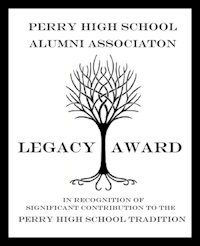Perry High School Alumni Association Legacy Awards
2022 – Frank Briscoe, Perry’s First Wrestling Coach
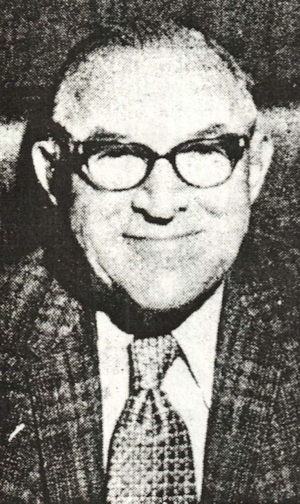 Frank Briscoe, the founder of Perry High School wrestling, was born on a farm north of Perry on Jan. 8, 1899, the son of Harry and Laura Elta Briscoe. He graduated from Perry High School in 1915, three years after his brother, Jack. Their family lived at 705 Ivanhoe.
Frank Briscoe, the founder of Perry High School wrestling, was born on a farm north of Perry on Jan. 8, 1899, the son of Harry and Laura Elta Briscoe. He graduated from Perry High School in 1915, three years after his brother, Jack. Their family lived at 705 Ivanhoe.
Briscoe entered Oklahoma A&M (now Oklahoma State University) in 1917 and became an outstanding wrestler, learning the sport under the legendary coach Ed Gallagher. While at A&M, he won wrestling championships for three successive years in the 145- and 158-pound weight categories. In 1920, he advanced to the finals of the National AAU in Birmingham, Alabama, but lost to wrestler Wanna Tikka, who won the AAU world title. In 1922, Briscoe was captain of the A&M wrestling team. He would sometimes wrestle in two different weight categories in the same match as he did in a 1922 match in which he won at 158 pounds by a fall and 175 pounds by a decision. He was commonly referred to as “Snake” and was acclaimed as the “scissor king.”
In 1928, he was one of 14 wrestlers from the southwestern United States to compete at the U.S. Olympic team trials in Grand Rapids, Michigan, but was defeated by a national champion from Iowa State.
In a 1932 Daily Oklahoman story titled “Poor Aggie Mat Boys So Bashful,” Gallagher recalled that Briscoe, while waiting to wrestle at matches, would act weak and out of shape to give his opponents false confidence. At one national match, Gallagher said, he heard an opponent remark, “Look over there at this Briscoe guy. He’s the one I’m going to meet in this round. It’ll be a cinch!” Later, said Gallagher, “They had to carry Frank’s opponent out of the ring after Frank got through with him.”
Briscoe graduated in 1922 with a bachelor of science degree in animal husbandry.
He was hired to teach agriculture and chemistry and coach football and other sports at Perry High School in 1922. During that year, the Perry Board of Education asked him to begin a wrestling program. By the end of his PHS tenure, the wrestling teams had won 42 dual matches, lost 6, and tied 2. The 1924 Peroma (PHS) yearbook noted that his football team was undefeated. He was the chairman of the State Wrestling Control Board and was considered one of Oklahoma’s best wrestling coaches, according to the 1927 yearbook.
Briscoe was the coach who taught Jack VanBebber, later an Olympic gold medalist, how to wrestle. He initially encouraged VanBebber in junior high to get stronger to help overcome a childhood injury and to defend himself against bigger boys. (A teacher had sent VanBebber to Coach Briscoe after a schoolyard fight.) VanBebber became a PHS wrestling champion. As a freshman at Oklahoma A&M, he lived with the Briscoes in Stillwater. VanBebber described this experience in his autobiography, “A Distant Flame: The Inspiring Story of Jack VanBebber’s Quest for a World Olympic Title.”
In 1925, Briscoe married Margaret Denton in Red Rock. They left Perry about 1927 to move to Stillwater, where he studied for a master’s degree and worked for his brother’s construction firm.
In 1929, Briscoe was hired at Sapulpa High School as a coach and teacher. (A Sapulpa newspaper story said he had been Heavener High School principal and athletic director.)
In Sapulpa, in addition to coaching wrestling and other sports, Briscoe worked as a referee at other high school and college competitions and taught at summer sports camps. He also taught wrestling to adults, according to a Sapulpa newspaper.
His next job came in 1935 when he moved to Tulsa’s Clinton High School, teaching classes and coaching wrestling and other sports there. He moved on to the new Daniel Webster High School after it opened as the new high school in that part of Tulsa three years later. As with many other men, his life changed in 1941. A Tulsa World story that year reported Briscoe leaving his high school position to work with his brother on a defense project. The story said that Briscoe’s teams had been “uniformly good.” He had been only the second wrestling coach hired at Webster.
Briscoe and his family then moved to Stillwater where he joined his brother in the construction business. For a time in the 1960s and 1970s he drove regularly to Perry to volunteer at the chamber of commerce every weekday morning, according to a Daily Oklahoman story. John Divine, his good friend and former student, was at that time the chamber manager. Divine had retired after 30 years of turning out exemplary wrestlers as the Perry High coach.
Briscoe died Sept. 15, 1975, in Stillwater, and was survived by his wife, brother, two sons, and eight grandchildren.
2019 – Floyd W. Pratt
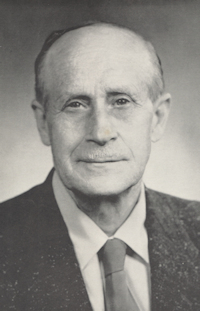 The Legacy Award for 2019 was presented to the family of the late, Floyd Pratt.
The Legacy Award for 2019 was presented to the family of the late, Floyd Pratt.
Floyd W. Pratt was a highly regarded educator for Perry Public Schools from 1929-1958. Floyd was born in Nebraska, moved to Waukomis, OK, where he attended school until his high school graduation. Floyd attended Kingfisher College and the University of Oklahoma from which he later received his master’s degree. Prior to that time, he attended the University of Kansas at Lawrence where he received his bachelor of Science degree. He also took graduate work at the Oklahoma A&M College in Stillwater, OK and Chicago University.
His teaching career began in 1912, in Vinita, OK, where he began teaching mathematics and history. He also served as the High School Principal. From there he went to Tulsa where he served four years as Head of the History Dept. From 1925-1928, Floyd was superintendent of schools at Sentinel where he also taught History. Beginning in 1929, he became a member of the Perry Faculty. It was commonly thought that probably Mr. Pratt taught more subjects than any other instructor in the Perry schools. Among the subjects he taught were Botany, Zoology, General Science, Mathematics, English, Spanish, Latin, Ancient, Medieval and Oklahoma History, Physics, and Problems of American Democracy.
On May 20, 1958, the Perry Daily Journal printed the following article, “SCHOOL YEARBOOK IS DEDICATED TO VETERAN TEACHER. The yearbook was dedicated to Floyd W. Pratt, who will retire after this term to end 28 years as a teacher in the Perry School System. The book contains a full-page picture of Pratt and a tribute to his many years of service.” The dedication in the yearbook reads, “With the sincere respect, the love, and the gratitude that are so rightfully his, we proudly dedicate this 1958 Maroon Spotlight to Mr. Floyd W. Pratt. By giving of his time and service for the benefit of our school, by serving our community in aiding students in the quest for learning and good citizenship and by molding lives in the true tradition of Perry High School, he is indeed a concrete example of the effort our school is making to produce fine, useful citizens of tomorrow.”
Mr. Pratt was active in the Perry Rotary Club, serving as president, and secretary-treasurer. While serving as secretary-treasurer Floyd was appointed an assistant sergeant-at-arms for the International Rotary Convention in Dallas, June 1958.
Floyd W. Pratt, September 22, 1888-October 1963, is buried with his wife, Clarice at Grace Hill Cemetery. They were the parents of eight children, three sons: Bill, Borger, TX; Stanley, Great Bend, KS (deceased); & Sterling, Los Angeles, CA; and five daughters: Mrs. Ronald (Joan) Harris, Yale, OK (deceased); Mrs. Jack (Judy) Phillippe, Port Huron, MI; Mrs. G. L. (Peggy) Wheeler, Philadelphia; Miss Catherine Pratt, Whittier, CA (deceased) & Mrs. Robert (Patsy) Pyle, Aurora, CO; and several grandchildren.
A few comments from past students:
Ernest John Kemnitz, ’48: “Floyd Pratt was an excellent teacher with innovative teaching ideas that kept his students interested. He wrote his thesis on Garfield County. In high school he was so light that when he caught the ball, his team mates threw him and the ball into the in-zone. He must have had a good sense of humor to tell that story to his Perry students. One of the things I remember is that he gave each student in the class a map of the United States. He challenged us to do the research and find the reason for the borders of each state. Another time we studied ESP. At least once, someone came to Perry to study Mr. Pratt’s teaching methods. I have watched Jeopardy for many years. My talent for knowing so many of the answers stems back to things taught to me by Mr. Pratt at PHS.”
Frances Davison Boone, ’52: “Mr. Pratt made history interesting. I will often know about something and realize that I learned it from Mr. Pratt.”
Marvin (Buddy) Jirous, ’53: “I remember that Mr. Pratt was very likeable and would often go out to smoke with the ‘boys’”. *You have to realize that everyone smoked at that time.
Karen Ream Studebaker, ’58: “Floyd Pratt developed the Problems of American Democracy class. He was beloved by all. Fascinating! My Mother took my sister Charlotte Ream Cooper and I to his house (he was a widower) one time for some reason and he got out all his current and previous passports and talked about his many travels. A fascinating man. We were fascinated with him. He must have been in his late 70’s at that time.”
Mildred Thompson Meyer, ’59: “Yes, Mr. Pratt was my History teacher in High School. He was a small man and some students feared him, but he was a man in charge. I loved him.”
David Severe, ’52: “I remember him. He was a small man and I remember when some big football players picked him up and held him out the second story window.”
Laural Hirschman Zavodny, ’55: “I always enjoyed his classes. I remember one time when wrestlers were arriving for a tournament, and our class was more interested in looking out the window at them than paying attention in class. He marched over to the windows and pulled down all the shades!”
2018 – Dr. Charles E. Martin
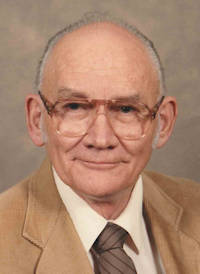 The Legacy Award for 2018 was presented to the family of the late Dr. Charles E. Martin. He graduated from Stillwater High School (1941), and from Oklahoma A&M College (1946), and completed his M.D. at OU (1948). He was committed to the education of Perry youth and was a member of the Perry Public Schools board of education 1959-74, serving two terms as president. He advocated for construction of the current Perry High School building. Dr. Martin was an active supporter of Perry Carnegie Library, serving on the board 1992-2002.
The Legacy Award for 2018 was presented to the family of the late Dr. Charles E. Martin. He graduated from Stillwater High School (1941), and from Oklahoma A&M College (1946), and completed his M.D. at OU (1948). He was committed to the education of Perry youth and was a member of the Perry Public Schools board of education 1959-74, serving two terms as president. He advocated for construction of the current Perry High School building. Dr. Martin was an active supporter of Perry Carnegie Library, serving on the board 1992-2002.
Dr. Martin was a devoted physician whose interest in treating illness and promoting good health lasted through his long career and retirement. He practiced in Perry from 1952 until his retirement in 2001. He was especially devoted to his obstetrical patients and enjoyed taking care of moms and babies. He delivered about 2,000 babies.
While serving his medical internship in 1948-49 at the University of Wisconsin, he met his future wife, Marjorie Billmeier. Soon after the Korean War began in 1950, Dr. Martin re-enlisted in the Army and became a battalion surgeon. He served in Korea for 10 months, treating wounded soldiers near the front lines and received the Bronze Star for “meritorious achievement in ground operations against the enemy in Korea.” After his Army service, he and Marjorie decided to move back to Oklahoma and chose Perry to begin his family practice.
He was active in the Boy Scouts of America as a boy and as an adult. In 1937, he attended the first Boy Scout Jamboree, held in Washington, D.C. From 1953 — 2000, Dr. Martin was active on the adult level. In 1963, he was the recipient of the Silver Beaver award, the top award given by the Will Rogers Council of the Boy Scouts.
Dr. Martin participated in many facets of community life that included: Perry Chamber of Commerce board of directors, Outstanding Citizen of the Year, Noble County Board of Health, Noble County Genealogy Society, Cherokee Strip Historical Society, American Legion Ellis-Jirous Post 53, Stagecoach Community Theatre, board director of First Bank and Trust 1959-89 and in 2007, he and his wife were parade marshals at the Cherokee Strip parade. After he retired, he could be found most days reading newspapers at the library, as well as talking with friends and checking out books. In 2010, the Perry Carnegie Library Reading Garden was dedicated to Charles and Marjorie.
He is survived by his wife, Marjorie, and their four children: Mary Ann (Gordon) Matzke, Kay (Tom) McCarthy, David (Julia Karlak) Martin and Ken (Mary) Martin.
2016 – Happy 50th, “Maroon Man” 1966-2016
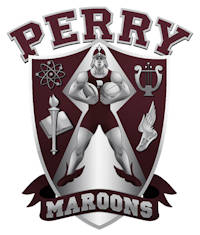
![]()
The inaugural award celebrated the 50th anniversary of the “PHS Maroon Man.” Harold Price, 1965-66 Student Council President, and Paul Ley, 1966 class member, provided their recollections of the birth of the “Maroon Man” and accepted the award on behalf of all who contributed. Many alumni from the class of 1966 were in attendance to celebrate their 50th reunion.

Maroon Man
Recollections of Harold Price.
My memory is that Perry High School students and staff were preparing to move in to the new high school in the process of being built. The student council decided that the school needed a visual representative (mascot) for the name, Perry Maroons.
Phillip Bartlett, Paul Ley and I were sitting around playing with the idea. We came up with two ideas, a pirate and a person who represented all of the academic and extra-curricular aspects of the school. Phillip drew an incredible pirate. Paul and I drew our concept of the all-around student.
We submitted both to a committee of students, teachers and administration. Much to our surprise the committee picked the all-around student to be our mascot. The three of us really favored the pirate but, apparently there were other pirate mascots in the state.
Paul and my sketches of the all-around student were a bit rough. I was working with the Balfour representive to pick the 1966 senior ring and showed him our sketch. He took it and gave it to a Balfour artist who created a 11 × 14 final rendering. That rendering became our official mascot in 1966. We called it, “The Maroon.”
